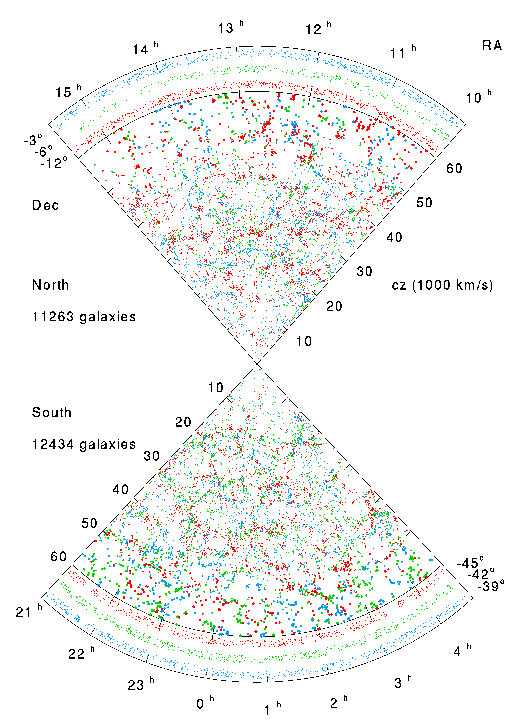Last time, I pointed out why LBQ was wrong when declaring that scientists claim without justification that "nothing has ever happened to change the physical laws that we know today". In fact, their claim that the ''Big Bang' must remain an interesting theory, and cannot be regarded as a fact" is false. As the cosmologist Jim Peebles has pointed out, "[t]hat the universe is expanding and cooling is the essence of the
big bang theory" [1] and there is no serious doubt that the universe has expanded from an initial condition characterised by both high temperature and high density.
LBQ's confused section on the Big Bang owes much to its poor grasp of scientific epistemology, as seen with its naive concept of 'facts' and 'theory', with the former being defined in an almost naively positivist way, and the latter conflated with 'hypothesis'. If you fail to properly define fact and theory, then your attack on a particular scientific theory will be hopelessly compromised.
In discussing the Big Bang, LBQ touches on some of the lines of evidence used as support for the Big Bang, but does so rather clumsily:
In discussing the Big Bang, LBQ touches on some of the lines of evidence used as support for the Big Bang, but does so rather clumsily:
Fact 1
When people use modern telescopes to look at distant galaxies they find that the light looks slightly different from sunlight. The simplest way we can describe this difference is to say that the light from distant galaxies looks slightly red. Hence this observation is known as the 'red shift'.
Fact 2
When we look out into outer space using a telescope already in space, we detect radiation known as cosmic microwave background radiation.
Fact 3
This fact involves the elements in the universe - things like hydrogen and helium, oxygen, nitrogen, carbon and so on. Scientists have noticed that the universe contains mainly elements that are light in weight. The lightest elements, hydrogen and helium, are by far the most common elements in the detectable universe.
Fact 4The evidence for the Big Bang is somewhat more than this. [2]
The fourth fact that is often mentioned is the fact that galaxies seem evenly spread through space. It does not matter in which direction we look, the spread of galaxies looks basically the same.
These are the four observable facts on which the 'Big Ban' [sic] theory is based
Large-scale homogeneity of the universe: on a large scale, the distribution of galaxies is uniform, that is, homogeneous. As Feuerbacher and Scranton show, using data from the Las Campanas Redshift Survey (provided by Ned Wright) we can see that a map of galaxy distance shows a uniform distribution over the survey area:
Data such as this shows that on a large scale, the universe is homogeneous, consistent with the Big Bang.
Hubble's Law: in 1926, the astronomer Edwin Hubble noted that spectral lines in distant galaxies were shifted towards the red end of the spectrum, with the red shift proportional to the distance from the observer. In other words, the further away the galaxy is, the faster it is receding from us. The classic Doppler shift, where the wavelength of sound or light from an object moving away from an observer increases, resulting in a decrease in audible frequency or a shift towards the red end of the spectrum provides an intuitive way of understanding what is happening.
However, rather than physically moving in space, space itself is expanding, and the light that passes through it is increasing in frequency. The longer the light passes through expanding space, the more it will be red-shifted. This relationship between red shift (velocity) and distance is well-established by the data, and is consistent with the Big Bang model:
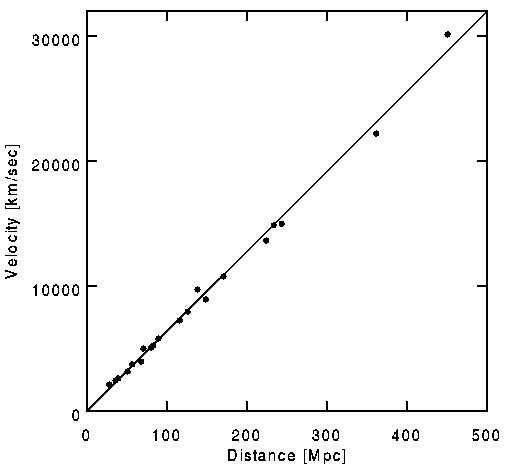 |
| Graph from Feuerbacher and Scranton. Data from Riess (1996) (provided by Ned Wright). |
Using the Big Bang model, we would be able to predict the relative abundance of these light elements. One would expect that as we look at distant, older objects, we would see a smaller fraction of heavy elements, eventually declining to nothing. As Feuerbacher and Scranton note, we see a good correlation between theory and observation with the Big Bang model, whereas the competing (and now discredited Steady State model fails to account for the data:
One of the major pieces of evidence for the Big Bang theory is consistent observations showing that, as one examines older and older objects, the abundance of most heavy elements becomes smaller and smaller, asymptoting to zero. By contrast, the abundance of helium goes to a non-zero limiting value. The measurements show consistently that the abundance of helium, even in very old objects, is still around 25% of the total mass of "normal" matter. And that corresponds nicely to the value which the BBT predicts for the production of He during primordial nucleosynthesis. For more details, see Olive 1995 or Izotov 1997. Also look at the plot below, comparing the prediction of the BBT to that of the Steady State model (data taken from Turck-Chieze 2004, plot provided by Ned Wright).
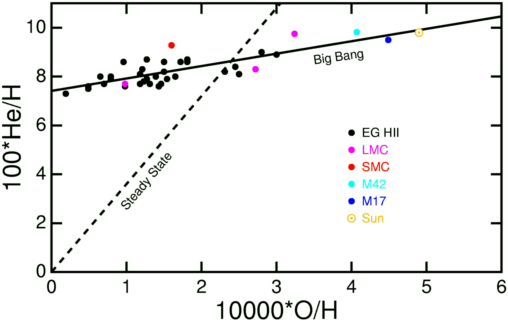
Cosmic microwave background radiation: this is one of the more spectacular predictions of the Big Bang theory. Around 400,000 years after the Big Bang commenced, atoms could form from electrons and nuclei, allowing photons to travel long distances without interacting with subatomic particles. Given the expansion of the universe, the wavelength of this electromagnetic radiation has been increasing over time. As Feuerbacher and Scranton note, the Big Bang theory allows us to make predictions about what this background radiation should look like:
From this basic picture, we can make two very strong predictions for this relic radiation:Both predictions have been confirmed. In 1965, Bell Lab scientists Arno Penzias and Robert Wilson, while trying to detect weak radio waves in found that even when taking steps to remove all possible interference, including removing heat-related interference from the receiver by cooling it to −269 °C (4K) they still detected a uniform background microwave radiation. This discovery was recognised as evidence for the Big Bang, and in 1978, Wilson and Penzias received the Nobel Prize in physics for this discovery.
The existence of this relic radiation was first suggested by Gamow along with Alpher and Herman in 1948. Their initial predictions correctly stated that the temperature of the radiation, which would have been visible light at decoupling, would be shifted into the microwave region of the electromagnetic spectrum at this point. That, combined with the fact that the source of the radiation put it "behind" normal light sources like stars and galaxies, gave this relic its name: the Cosmic Microwave Background Radiation (CMBR or, equivalently, just CMB).
- It should be highly uniform. One of the basic assumptions of BBT is that the universe is homogeneous and, given the time between the beginning of the universe and decoupling, any inhomogeneities (like those expected from inflation) would not have much time to grow.
- It should have a blackbody spectrum. As we said before, prior to decoupling the universe was full of plasma and photons were constantly scattering off of all of the ionized matter. This makes the universe a perfect absorber; no photons could leave the universe, so they would put the whole universe (or at least that part that was causally connected) in thermal equilibrium. As such, we can actually describe the universe as having a unique temperature. In classical thermodynamics, photons emitted by a blackbody at a given temperature have a very specific distribution of energies and, as Tolman showed in 1934, a blackbody spectrum will remain a blackbody spectrum (albeit at a lower temperature) as it redshifts.
Ground-based measurements of cosmic radiation are hampered by atmospheric absorption, so astronomers have carried out many upper atmosphere and space-based experiments to better measure and characterise this radiation, and this is where COBE (COsmic Background Explorer) satellite provided data that confirmed the second prediction. Feuerbacher and Scranton again:
COBE was actually several experiments in one. The DMR instrument measured the anisotropies in the CMBR temperature across the sky (see more below) while the FIRAS experiment measured the absolute temperature of the CMBR and its spectral energy distribution. As we mentioned above, the prediction from BBT is that the CMBR should be a perfect blackbody. FIRAS found that that this was true to an extraordinary degree. The plot below (provided by Ned Wright) shows the CMBR spectrum and the best fit blackbody. As one can see, the error bars, which are quite small, are actually 400 standard deviations. In fact, the CMBR is as close to a blackbody as anything we can create here on Earth. (Emphasis mine)
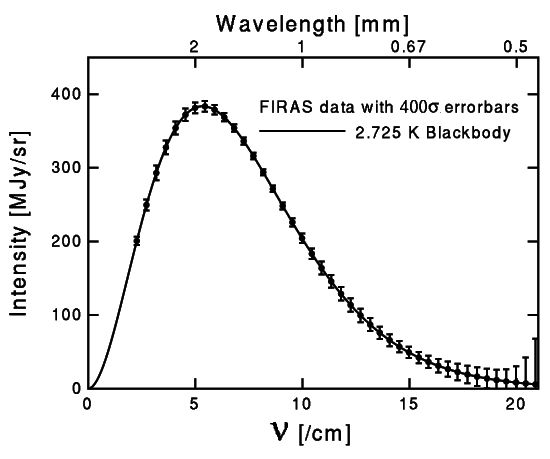
Fluctuations in the cosmic microwave background radiation: While the uniform background radiation is consistent with a Big Bang, it raises the question of how a lumpy distribution of matter (galaxies, star clusters) could form from a uniform distribution of gas. One would expect to see fluctuations in this background radiation which would act as 'seeds' that would trigger the formation of large-scale structure in the universe.
COBE made the first measurement of the background radiation fluctuations in the early 19990s, with further information gathered from balloon-based instruments. While showing what appeared to be fluctuations, problems with instrument sensitivity and interference from thermal radiation from the Earth meant that the readings, though consistent with the Big Bang, did lack precision.
The WMAP probe was launched in 2001 in order to overcome the problems of resolution and thermal interference that had hampered the previous COBE experiment. As Feuerbacher and Scranton note, WMAP not only provided superb data, but allowed scientists to determine the age of the universe with astonishing precision:
LBQ's failure to properly research the Big Bang, coupled with their deeply flawed grasp of the epistemological basis of modern science are both clearly seen with their implication that scientists have made these unwarranted assumptions, and because of this, the Big Bang is suspect:
We've already seen that the first assumption is anything but unwarranted. As the old earth creationist Christadelphian John Bilello has noted, "the constancy of the physical laws of the universe from creation to the present is an assumption that we find completely agreed upon in both biblical and scientific thought." It is frankly mystifying how LBQ would argue otherwise. The second assumption is likewise anything but unjustified. Again, as another old earth creationist astronomer Hugh Ross notes:
The WMAP probe was launched in 2001 in order to overcome the problems of resolution and thermal interference that had hampered the previous COBE experiment. As Feuerbacher and Scranton note, WMAP not only provided superb data, but allowed scientists to determine the age of the universe with astonishing precision:
Unlike COBE, WMAP was focused entirely on the question of measuring the CMBR fluctuations. Drawing from the experience and technological advances developed for the balloon missions, it had much better angular resolution than COBE (see the image below from the NASA/WMAP Science Team). It also avoided one of the problems that had plagued the COBE mission: the strong thermal emission from the Earth. Instead of orbiting the Earth, the WMAP satellite took a three month journey to L2, the second Lagrangian point in the Earth-Sun system. This meta-stable point is beyond the Earth's orbital path around the Sun, roughly one tenth as far as the Earth is from the Sun. It has been there, taking data, ever since.Specifically, the WMAP data not only showed with considerable resolution the background radiation fluctuations, but validated the currently accepted Big Bang model, the Lambda CDM theory:
Comparsion of the sky maps taken by COBE and WMAP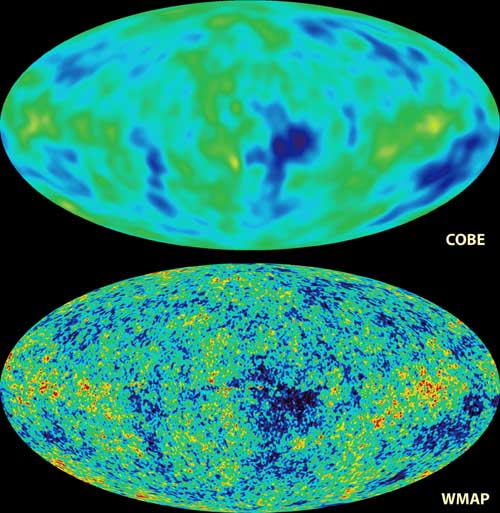
In the spring of 2003, results from the first year of observation were released - and they were astonishing in their precision. As an example, for decades the age of the universe had not been known to better than about two billion years. By combining the WMAP data with other available measurements, suddenly we knew the age of the universe to within 0.2 billion years.
As with the COBE temperature measurement, the agreement between the predicted shape of the CMBR power spectrum and the actual observations is staggering. The balloon-borne experiments (particularly BOOMERang, MAXIMA, and DASI) were able to provide convincing detections of the first and second acoustic peaks before WMAP, but none of those experiments were able to map a large enough area of the sky to match with the COBE DMR data. WMAP bridged that gap and provided much tighter measurement of the positions of the first and second peaks. This was a major confirmation of not only the Lambda CDM version of BBT, but also the basic picture of how the cosmos transitioned from an early radiation-dominated, plasma-filled universe to the matter-dominated universe where most of the large scale structure we see today began to form.Two things should be apparent from this. The first is that the universe is old, expanding, and originated in a hot dense state. The second is that the currently accepted version of the Big Bang theory - like all good scientific theories - has considerable predictive and explanatory power. When LBQ asserts that it the "'Big Bang' must remain an interesting theory, and cannot be regarded as a fact", not only are they making the usual special creationist mistake of confusing 'theory' with 'wild guess or hypothesis', they are specifically wrong. As the highly respected cosmologist Jim Peebles has said, the essence of the Big Bang theory is that the universe is expanding and cooling, and this is not in doubt.
LBQ's failure to properly research the Big Bang, coupled with their deeply flawed grasp of the epistemological basis of modern science are both clearly seen with their implication that scientists have made these unwarranted assumptions, and because of this, the Big Bang is suspect:
Scientists then make the following assumptions:
Using these three assumptions, together with our four observable facts, it becomes obvious that if our universe is expanding, then, if we roll back time, everything can be traced back to a single point in space time from which it all started. And that is what is called the 'Big Bang'.
- Nothing has ever happened to change the physical laws that we know today.
- These laws are consistent and the same throughout the whole of the universe.
- The red shift is caused by the light source moving away from us.
On June 5, 2013, four astrophysicists from the Center for Cosmology at the University of California, Irvine posted a preprint of a paper they submitted to Physical Review Letters. There they present analysis of the Planck satellite map for the purpose of constraining spatial variations in the fine-structure constant. The UC Irvine team noted that spatial variations in the fine-structure constant would cause higher order correlations in the temperature fluctuations of the cosmic background radiation. These correlations, they explained, would result from Thompson scattering of cosmic background radiation photons.
Failure to detect any such correlations led the research group to conclude that the fine-structure constant did not vary from place to place within the entire extent of the cosmos, at least at the epoch of the first formation of atoms. However, the team also concluded that this particular constraint was not very robust. They were able to place a limit of 1.34 ± 5.82 x 10-2 for angular scales of tens of degrees and above on the possible variations. That is, they established that the fine-structure constant cannot vary spatially over the extent of the cosmos by more than ten percent.Finally, their assertion on the red shift makes the fundamental error of assuming that the cosmological red shift is caused by physical motion of the light source away from the observer, analogous to the drop in pitch of a siren moving away from an observer. Rather, this is due to the passage of electromagnetic radiation through expanding space. As Feuerbacher and Scranton point out:
At the start of their analysis, the UC Irvine team acknowledged that they were not likely to achieve a robust constraint. However, they also knew that the ESA is committed to continually operating the Planck satellite for many more years to come. As with the WMAP, several years of integrated data should produce a substantially more detailed map of the cosmic background radiation (see figures 2 and 3). The team’s primary goal in their published study was to show that their analysis technique can produce meaningful results. With better data, their technique will produce a robust constraint. As it is, scientists can derive satisfaction in the results produced so far.
Researchers have demonstrated—to a spectacular degree far greater than what was possible just a few years ago—that fundamental constants in physics remained fixed over the history of the universe. For the first time, astronomers have confirmed the constancy of the physical laws to the entire geographical extent of the universe. Physicists and astronomers have also developed proof-of-principle experiments and observations that soon will enable them to extend by a few orders of magnitude (factors of ten to a thousand) the precision by which they can further put the physical laws to the test. [3] (Bold emphasis mine)
Cosmological redshift is often misleadingly conflated with the phenomenon known as the Doppler Effect. This is the change in wavelength (either for sound or light) that one observes due to relative motion between the observer and the sound/light source. The most common example cited for this effect is the change in pitch as a train approaches and then passes the observer; as the train draws near, the pitch increases, followed by a rapid decrease as the train gets farther away. Since the expansion of the universe seems like some sort of relative motion and we know from the discussion above that we should see redshifted photons, it is tempting to cast the cosmological redshift as just another manifestation of the Doppler Effect. Indeed, when Edwin Hubble first made his measurements of the expansion of the universe, his initial interpretation was in terms of a real, physical motion for the galaxies; hence, the units on Hubble's Constant: kilometers per second per megaparsec.
In reality, however, the "motion" of distant galaxies is not genuine movement like stars orbiting the center of our galaxy, Earth orbiting the Sun or even someone walking across the room. Rather, space is expanding and taking the galaxies along for the ride.
The best-known attempt to explain Hubble's law without recourse to an expanding universe is the Tired Light cosmology, and as cosmologist Ned Wright shows, this model is flawed:
Tired light models invoke a gradual energy loss by photons as they travel through the cosmos to produce the redshift-distance law. This has three main problems:Given this, LBQ's objections not only are unimpressive, but show a failure to understand the subject they are criticising.
- There is no known interaction that can degrade a photon's energy without also changing its momentum, which leads to a blurring of distant objects which is not observed. The Compton shift in particular does not work.
- The tired light model does not predict the observed time dilation of high redshift supernova light curves. This time dilation is a consequence of the standard interpretation of the redshift: a supernova that takes 20 days to decay will appear to take 40 days to decay when observed at redshift z=1. In 2001 Goldhaber and the Supernova Cosmology Project published results of a time dilation analysis of 60 supernovae. A plot of their width factor w versus the redshift z is shown below.
If the redshift were due to a tired light effect, the width of a supernova light curve would be independent of the redshift, as shown by the red horizontal line. If the redshift is due to an expanding Universe, the width factor should be w = (1+z) as shown by the blue line. The best fit to the data is the black line, and it is clearly consistent with the blue line and rules out the tired light model. My best fit line is 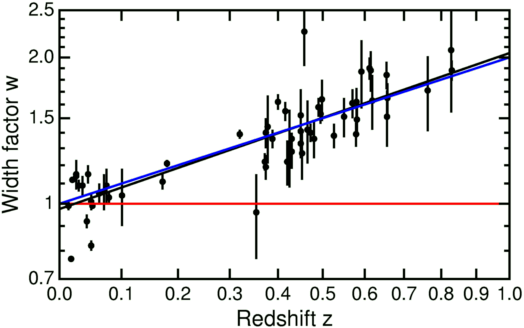
w = 0.985*(1+z)(1.045 +/- 0.089)using a least sum of absolute errors robust estimator to find the fit and the half-sample bootstrap to estimate the errors. This data excludes the tired light model by more than 11 standard deviations. Blondin et al. (2008) also studied distant supernovae, but used spectra to judge the age of the supernovae. They found an aging rate that varied like
1/(1+z)(0.97 +/- 0.10),compatible with the expected 1/(1+z) for expanding Universes, but 9.7 standard deviations away from the constant aging rate expected in the tired light model.- The tired light model can not produce a blackbody spectrum for the Cosmic Microwave Background without some incredible coincidences.
No one is arguing that the currently accepted Big Bang theory is law - that is not how science works given that a good theory is one that not only has predictive and explanatory properties, but can be falsified. However, any successor theory would need to account not only for the phenomena that the previous Big Bang theory could not explain, but the phenomena that it could, and these phenomena include the reality of an old, expanding universe that originated in a hot, dense state.
Christadelphian Support for the Big Bang
Other Christadelphians have been less dismissive of the Big Bang, and more willing to listen to what the universe tells us about its origins, rather than privilege human dogma. Shortly after the initial COBE data was released, The Christadelphian cautiously but positively responded to this discovery, though doing so through a strongly apologetic lens:
The observations in fact represented not so much a totally new discovery but confirmatory evidence for the theory, now nearly 30 years old, that the universe came into being as the product of a ‘Big Bang’—a cataclysmic event in which a primaeval fire-ball containing all the matter in the universe exploded with ferocious energy, hurtling fragments at immense speeds into space. From these (in the course of hundreds of thousands of years) condensed the galaxies we can now see through modern telescopes, including our own Milky Way, a tiny part of which is occupied by the solar system, within which—a mere speck—is planet earth.What man has now reported is, as it were, the ‘echo’ of the Big Bang: the ripples left in space by the expanding cloud of matter and energy; or, as some astronomers express it, a ‘lumpiness’ in the universe.
Our own reactions to these things may be mixed: we have faith in God and believe in creation irrespective of man’s probings into space; but we may actually find that it assists our faith, and provides a point of contact with those to whom we talk, to know that scientists are actually prepared to speak of a ‘beginning’ to time, and even allow a ‘first cause’—even if they are reluctant to refer to God. [4]Another (more supportive) Christadelphian voice in support of the Big Bang is John Bilello who points out that:
The inescapable conclusion of the observations of Hubble was that the universe was not static, but was expanding. Furthermore, more recent and more exacting detailed measurements confirm quite remarkably these early observations that Hubble made on a telescopic instrument that seems very primitive today. Since it is well-known that matter cannot move faster than the velocity of light, it was possible to put an upper limit on the red-shift and get both an idea of the distance limits of the universe and also estimate how long it took for the universe to get to its present size. We will have more to say on this in a later article on the “Big Bang,” but for now it will suffice to say that the results found by Hubble had, in fact, been predicted earlier by the general theory of relativity in its initial version without the cosmological constant correction that Einstein made to force a static universe. That is why Einstein called this his biggest blunder; it remains to be seen whether or not some future result on “dark matter and energy” may yet prove that the cosmological constant has some sort of physical reality.Given both the OEC heritage of our community, and the alacrity with which some in our community have used the Big Bang for apologetic purposes, it is indeed puzzling how LBQ has opted to take an overtly denialist stance on this subject.
The point that is overwhelmingly accepted by scientists today is that all the theories and observations of twentieth century cosmological physics indicate beyond the shadow of a doubt that the universe had a “beginning.” [5] (Emphasis in original)
Conclusion
No apology is made for the length of this post as it is important to emphasise why LBQ's dismissive stance towards the Big Bang represents both a failure to properly understand why scientists regard the Big Bang model as convincing, as well as the usual special creationist misunderstanding of scientific epistemology, as shown by their failure to grasp what is meant in science by theory. When LBQ asserts:
We must remember that this theory is based on what we can see today. No one knows what information modern telescopes would have given us thousands or millions of years ago. We must also remember that we cannot do any experiments to prove that the red shift is caused by the light source moving away from usthey are simply wrong. Contrary to what they assert, we do know what happened thousands of millions of years ago because we can see what happened. Given (1) the finite speed of light and (2) the remote distance of stars and galaxies, the light we see from them is a window into what happened in the past. In passing, this observational window into the past has shown us that nuclear half lives have remained constant over billions of years by observing decay rates in distant supernovae:
We can see that, contrary to the impression you may already have, there are not many facts that support the 'Big Bang' theory. The few facts we do have support the theory if we accept the assumptions that we cannot prove. Scientists are doing their best with the available information. But, like the miasma and dyscrasia theories we looked at earlier, we may be missing some important information
Supernovae are known to produce a large quantity of radioactive isotopes (Nomoto et al. 1997a, 1997b; Thielemann et al. 1998). These isotopes produce gamma rays with frequencies and fading rates that are predictable according to present decay rates. These predictions hold for supernova SN1987A, which is 169,000 light-years away (Knödlseder 2000). Therefore, radioactive decay rates were not significantly different 169,000 years ago. Present decay rates are likewise consistent with observations of the gamma rays and fading rates of supernova SN1991T, which is sixty million light-years away (Prantzos 1999), and with fading rate observations of supernovae billions of light-years away (Perlmutter et al. 1998). [6]This providing another line of evidence that specifically refutes LBQs assertion that assuming the constancy of physical laws over time is unwarranted. In short, their claim that "there are not many facts that support the 'Big Bang' theory' is spectacularly wrong, as this article has shown, and alone is enough to destroy the credibility of their entire article on science and the Bible.
The problem with linking apologetics with demonstrably false claims is that the educated reader will be entirely justified in assuming that if LBQ has got the science so completely wrong, they will also have got their theology wrong, and give our community a wide berth. James 3:1 states that those who teach will be judged more strictly. We need to recognise that this judgement is made not just by informed members of our community who are obligated to point out publicly-declared error, but by those to whom we are trying to reach.
References
1. Peebles P.J. "Making Sense of Modern Cosmology" Scientific American (January 2001) p 44
2. I am indebted to Björn Feuerbacher and Ryan Scranton for their article Evidence for the Big Bang for much of the discussion on this subject.
3. Ross H. "Stronger and More Comprehensive Tests Affirm the Universe's Unchanging Physics" Reasons to Believe July 1 2013
4. 'Signs of the Times' The Christadelphian (1992) 129:229
5. Bilello J "Bible and Science (2): In the Beginning" The Tidings July 2003
6. Claim CF210: Constancy of Decay Rates TalkOrigins
